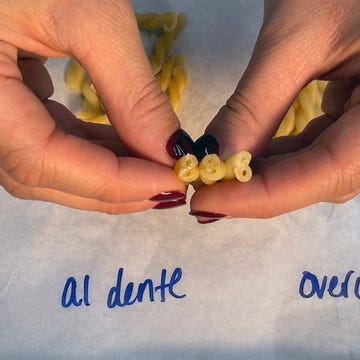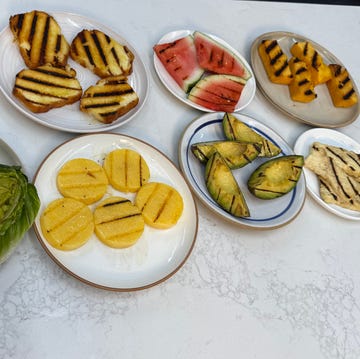If you’ve spent any time on the internet, you know that discourse surrounding picky eaters can get heated. For some, food aversions are grounds for bullying or even dating deal-breakers. People can be shamed for simply ordering chicken tenders at a restaurant.
From an outside perspective, it’s easy to chalk it up to an unwillingness to try new things. But the factors that contribute to food aversions can be far more complicated—and moving past them isn’t as simple as some may believe. The medical community still does not have a complete grasp on the science behind so-called "picky eating." But keeping up with what we do know can help us empathetically interact with food-averse people and learn how to overcome our own aversions.
To break it all down, we consulted H. Coakley, MSPH, RDN, a registered dietitian and nutrition therapist who specializes in disordered eating. Here’s what you should know about food aversions and how to approach them:
How Do Picky Eating Habits Develop?
It all comes down to the individual, and even then, it’s hard to narrow down a definitive answer. “There is honestly still quite a lot that we don't know about food aversions,” Coakley says. More research is needed to uncover more of the science behind them, but we know that there can be several psychological factors at play.
“The one that I am most familiar with is trauma, particularly early childhood trauma, but there are others, such as gastrointestinal or ENT issues in very early childhood, that can create negative associations with food,” Coakley explains. They add that a correlation is evident between food aversions and neurodivergence—but the relationship between the two needs to be further explored.
“What we do know quite clearly about food aversions is that they are extremely visceral, involuntary responses and, as such, do not really shift with ‘traditional’ psychological interventions,” they say.
What Techniques Can Help People Overcome Food Aversions?
Addressing food aversions, just like their origins, is individual and complex. That being said, Coakley employs a few useful techniques to help others adjust their eating habits.
Food Chaining
"I know that one of the most effective practices I use in my work is a technique called food chaining, which helps someone grow comfortable with certain foods through progressive incorporation with foods that they are already familiar with—[whether that's through] taste, texture, shape, or other characteristics—and enjoy or feel neutral about," they say. The process is nuanced, but they cite an example of a person learning to enjoy strawberries to understand the basics of the method.
First, someone would combine plain yogurt with strawberry yogurt until they feel comfortable eating a bowl of just strawberry yogurt. From there, they would pair the strawberry yogurt with a food they already enjoy, like cereal. This combination would provide a safe foundation for integrating chopped fresh strawberries. After growing more comfortable with the addition of chopped strawberries, the person may eventually learn to enjoy eating them on their own. Gradually, the person would work up to eating whole strawberries.
The Right Environment
In the same vein, establishing a comfortable environment makes a big difference. Giving someone enough time to explore and investigate unfamiliar foods allows them to mentally prepare themselves and develop an interest in trying them. Tasting food for the first time in public spaces like restaurants may not be conducive for food-averse people. Instead, opting for a comfortable and calm space can be more effective. "The bowl or plate and the utensils that they use can be really important in bringing a sense of familiarity as well," Coakley adds.
Coakley's approach is rooted in organic exploration and curiosity instead of forcing new foods into one's diet. "I also encourage my clients to consider what we are practicing as a meaningful skill, even if they wind up not liking what we try—rather than an ultimatum where you have to learn to like some particular food or else," they say.
While Coakley's expertise is focused on adults, they argue that it's best to start tackling food aversions as early as possible. Many disordered eating patterns involving food aversions develop in childhood, which often become more difficult to overcome as an adult. "
"The process can be very slow, but as people build more confidence with food it does become easier to continue trying new foods and food combinations—while also knowing when they can say 'no' to something," they say.
What Is The Best Way To Interact With Food-Averse People?
The ideal approach can be summed up with two words: patience and kindness. “Food aversions are not someone being stubborn, willful or ‘picky,’” Coakley says. “They are an intense and overwhelming feeling of fear and or disgust when trying certain foods and sometimes when trying almost any foods.”
These feelings of fear and disgust can be deeply rooted, especially if they developed at a young age. The complicated psychology behind them means they won’t simply go away on their own. And, like in most other situations, approaching food aversions with harshness or judgement isn’t an effective treatment method either.
Coakley explains that these reactions happen automatically and can’t be controlled by simply trying harder or by using threats, shame, or punishment. Instead, it's best to meet food-averse people where they are and to exercise patience.
"I find that lack of compassion can really add a lot of unneeded pressure for someone who is already navigating an incredible amount of stress or fear to be able to manage their food aversions," they say. "Gentle, genuine encouragement is key."













